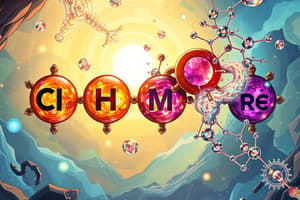Podcast
Questions and Answers
What is the primary focus of inorganic chemistry?
What is the primary focus of inorganic chemistry?
- Behavior of living organisms
- Properties of carbon-based molecules
- Elements and their compounds excluding carbon-based molecules (correct)
- Chemical reactions in organic compounds
Who is credited with the development of the periodic table?
Who is credited with the development of the periodic table?
- Dmitri Mendeleev (correct)
- Louis Pasteur
- Robert Boyle
- Marie Curie
What is the significance of periodicity in inorganic chemistry?
What is the significance of periodicity in inorganic chemistry?
- It determines bond types
- It explains organic compound structures
- It focuses on energy storage mechanisms
- It helps predict properties and reactions of elements (correct)
Which of the following is an example of a polyatomic ion?
Which of the following is an example of a polyatomic ion?
Why is understanding bond types and polyatomic ions important in inorganic chemistry?
Why is understanding bond types and polyatomic ions important in inorganic chemistry?
What is the primary focus of coordination compounds in inorganic chemistry?
What is the primary focus of coordination compounds in inorganic chemistry?
Which theory explains how ligands affect the electronic structure of a central metal ion?
Which theory explains how ligands affect the electronic structure of a central metal ion?
In solid state chemistry, what relationship do chemists examine between molecular composition, crystal lattice arrangements, and physical properties?
In solid state chemistry, what relationship do chemists examine between molecular composition, crystal lattice arrangements, and physical properties?
Which environmental applications does inorganic chemistry offer practical solutions for?
Which environmental applications does inorganic chemistry offer practical solutions for?
Which instrumental analytical tool is commonly used in inorganic chemistry to elucidate chemical compositions and structural features in diverse samples?
Which instrumental analytical tool is commonly used in inorganic chemistry to elucidate chemical compositions and structural features in diverse samples?
Study Notes
Unraveling Inorganic Chemistry's Enchantment
Inorganic chemistry is one of two primary branches of chemistry — alongside organic chemistry — which focuses on the behavior and properties of elements and their compounds excluding carbon-based molecules like those found in living organisms. This realm abounds with captivating stories about atoms and molecules binding together to form unique materials, each revealing a multitude of fascinating phenomena and applications across various fields.
Periodicity and Organizational Principles
One of the most fundamental concepts in inorganic chemistry is periodicity, derived from Dmitri Mendeleev's groundbreaking work on the arrangement of chemical elements based on increasing atomic weights. His periodic table allowed chemists to understand elemental similarities and trends among different groups and periods — a systematic organization essential for predicting properties and reactions.
Bond Types and Polyatomic Ions
The cornerstone of inorganic chemistry incorporates several types of covalent bonds and ionic interactions between metal and nonmetal elements. These bond types manifest themselves through polyatomic ions like nitrate (${\rm NO}_3^{-}$), sulfate ${\rm SO}_4^{2-}$, or phosphate $(PO_4)^{3-}$. Conceptually grasping these complex entities can be challenging; however, understanding them lays the foundation for comprehending numerous processes such as corrosion, catalysis, and energy storage.
Coordination Compounds and Crystal Field Theory
Coordination compounds represent another crucial area of focus within inorganic chemistry; they involve transition metals forming bonds with other elements around a central atom or ion. Understanding coordination compounds requires familiarization with crystal field theory, which explains how ligands surrounding the central metal ion affect its electronic structure. A classic example discussing this concept involves octahedral geometry observed in compounds containing six-coordinated metal centers.
Solid State Chemistry and Materials Science
A large portion of inorganic chemistry deals with solid state structures and materials science, where chemists examine intricate relationships between molecular composition, crystal lattice arrangements, and physical properties emerging due to intermolecular forces, like metallurgy, ceramics, and glasses. For instance, analyzing the crystal structure of lithium ion batteries helps researchers optimize electrode materials and battery performance.
Environmental Applications and Pollution Control
Given our growing awareness of environmental concerns, inorganic chemistry offers practical solutions in pollution control, wastewater treatment, and solid waste management. Several standard methods utilized by environmental scientists revolve around extractive techniques employed during industrial processing or remediation activities, involving precipitation, adsorption, membrane separation, and oxidation/reduction reactions.
Analytical Techniques and Spectroscopy
Lastly, inorganic chemistry emphasizes various instrumental analytical tools, including spectrophotometry, atomic absorption spectrometry, X-ray diffraction, and nuclear magnetic resonance (NMR) spectroscopy. Each method contributes significantly towards elucidating chemical compositions, structural features, and interaction dynamics in diverse samples ranging from minerals and alloys to pharmaceuticals and biomaterials.
In summary, inorganic chemistry has laid a strong foundation for countless scientific achievements, advancing knowledge beyond its fundamental scope into technology and applications far exceeding our everyday expectations. Thus, embracing the study of inorganic chemistry will undoubtedly pave the pathway toward uncovering new realms of discovery and innovation, enriching both academic pursuits and global developments alike.
Studying That Suits You
Use AI to generate personalized quizzes and flashcards to suit your learning preferences.
Description
Explore the captivating realm of inorganic chemistry, delving into concepts like periodicity, bond types, coordination compounds, solid state chemistry, environmental applications, and analytical techniques. Learn about the behavior and properties of elements and compounds excluding carbon-based molecules, and their diverse applications across various fields.




